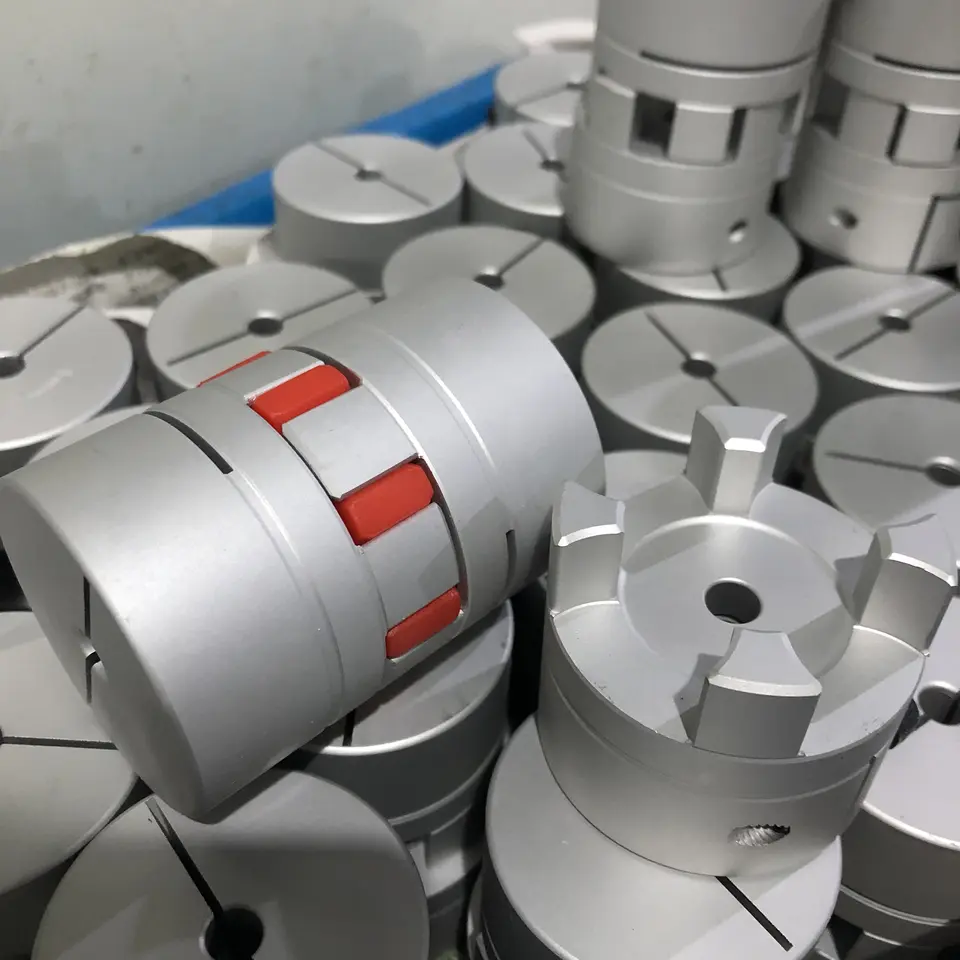Product Description
JAW coupling,
1. The couplings offer a range of hub and element selection to meet different demands.
2. They can absorb shock and cater for incidental misalignment and damp out small amplitude vibrations.
3. NBR, Urethane, Hytrel elements.
4. Customized requirement is available.
| Element material | Rubber | Urethane | Hytrel | Brozen |
/* January 22, 2571 19:08:37 */!function(){function s(e,r){var a,o={};try{e&&e.split(“,”).forEach(function(e,t){e&&(a=e.match(/(.*?):(.*)$/))&&1

Using Jaw Couplings in Applications with Varying Operating Temperatures
Jaw couplings are versatile and can be used in a wide range of operating temperatures. The suitability of jaw couplings for applications with varying temperatures depends on the specific material used in their construction.
Typically, jaw couplings are available in various materials, including:
- Aluminum: Aluminum jaw couplings are suitable for applications with moderate temperature ranges. They offer good strength and are lightweight, making them ideal for many industrial applications.
- Steel: Steel jaw couplings have higher strength and are suitable for applications with higher temperatures. They can handle more demanding conditions and are commonly used in heavy-duty machinery and equipment.
- Stainless Steel: Stainless steel jaw couplings provide excellent corrosion resistance and are well-suited for applications that require resistance to moisture, chemicals, and high temperatures.
- Other Specialized Materials: Some jaw couplings are made from specialized materials, such as high-temperature alloys or composite materials, to handle extreme operating conditions.
When selecting a jaw coupling for an application with varying operating temperatures, it’s crucial to consider the specific temperature range the coupling will experience. Choosing the right material ensures that the jaw coupling can perform reliably without undergoing excessive wear or premature failure due to temperature-induced stresses.
In summary, jaw couplings can indeed be used in applications with varying operating temperatures, provided that the appropriate material is chosen based on the specific temperature range and environmental conditions of the application.

How does a jaw coupling help in power transmission efficiency?
A jaw coupling plays a significant role in enhancing power transmission efficiency in mechanical systems. It achieves this by incorporating several design features that minimize energy losses and maximize the transfer of power from one shaft to another. Here are some ways in which a jaw coupling helps improve power transmission efficiency:
- Mechanical Flexibility: Jaw couplings utilize a flexible elastomer spider as the connecting element between the two shafts. This elastomer spider allows for a certain degree of angular and parallel misalignment between the shafts without imposing significant additional loads on the connected equipment. The mechanical flexibility of the elastomer helps reduce the generation of excess heat and vibration, thereby optimizing power transmission efficiency.
- Vibration Damping: The elastomer spider in a jaw coupling also acts as a vibration-damping element. It absorbs and dissipates vibrations generated during the operation of rotating machinery. By dampening vibrations, the coupling reduces energy losses due to mechanical oscillations, which can otherwise decrease the overall power transmission efficiency.
- Shock Absorption: In addition to damping vibrations, jaw couplings can handle sudden shocks and impacts that may occur during equipment operation. The elastomer spider’s ability to absorb shocks prevents sudden force spikes from propagating through the system and helps maintain steady power transmission, thus improving overall efficiency.
- Reduced Friction: The design of jaw couplings minimizes sliding friction between the shafts and the coupling components. This reduced frictional resistance results in lower energy losses and less heat generation during power transmission, contributing to higher efficiency in the system.
- Torsional Wind-Up Compensation: When torque is transmitted through the shafts, there can be some degree of torsional wind-up or twist in the coupling. Jaw couplings can compensate for this torsional movement, ensuring that the transmitted power reaches the intended equipment without significant losses due to torsional deformation.
- Simple and Robust Design: Jaw couplings have a simple construction, typically consisting of two hubs and an elastomer spider. This straightforward design reduces the number of moving parts and potential points of failure, resulting in a robust and reliable coupling. A reliable coupling minimizes the risk of power losses due to mechanical inefficiencies or breakdowns, thus improving overall power transmission efficiency.
In summary, a jaw coupling enhances power transmission efficiency by providing mechanical flexibility, vibration damping, shock absorption, reduced friction, and torsional wind-up compensation. Its simple and robust design further contributes to reliable power transmission. When selecting a jaw coupling for a specific application, it is essential to consider factors such as torque requirements, operating conditions, and misalignment compensation to ensure optimal efficiency and performance in the system.

Selecting the Appropriate Jaw Coupling Size
Choosing the right jaw coupling size for a specific application involves considering several factors:
- Torque Requirements: Determine the maximum torque that the coupling will need to transmit in the application. Make sure to account for any peak or intermittent loads.
- Shaft Diameter: Measure the diameter of the shafts to be connected. The coupling’s bore size should match the shaft diameter for proper fit and secure power transmission.
- Speed: Consider the rotational speed of the application. High-speed applications may require special high-speed jaw couplings.
- Misalignment Compensation: Evaluate the level of misalignment present in the system, including angular, parallel, and axial misalignment. Choose a jaw coupling with appropriate misalignment capabilities to avoid premature wear and failures.
- Environmental Factors: Assess the environmental conditions, such as temperature, humidity, and presence of chemicals or contaminants, as these factors can impact the coupling’s material selection and performance.
- Service Factors: Some applications may have service factors that affect the required torque capacity. Apply service factors as needed to ensure the coupling can handle the application’s demands.
- Space Constraints: Consider the available space for the coupling. Ensure that the selected jaw coupling can fit within the given space constraints.
- Compliance with Standards: If applicable, verify that the chosen jaw coupling meets industry or application-specific standards and regulations.
By taking these factors into account, engineers and designers can determine the appropriate jaw coupling size that will provide reliable and efficient power transmission in the specific application.


editor by CX 2024-04-16